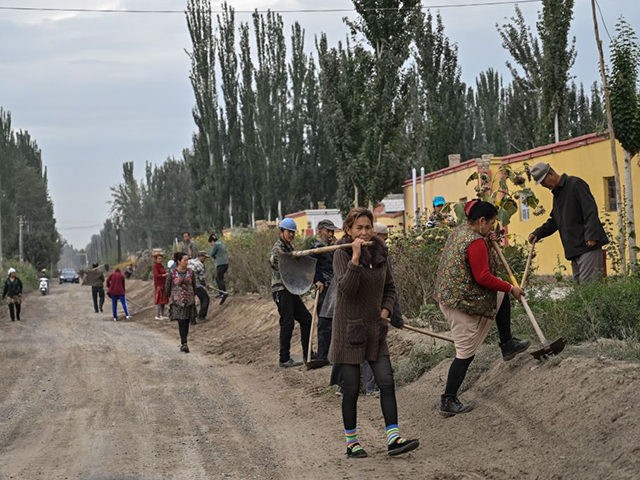Chinese customs data reviewed by the South China Morning Post (SCMP) on Tuesday showed exports from the Xinjiang region to the United States nearly tripled year-on-year in September 2022, despite tougher scrutiny for forced labor imposed by the Uyghur Forced Labor Prevention Act (UFLPA).
The UFLPA, which was passed in December 2021 and went into effect in June 2022, effectively assumes all products from Xinjiang are tainted with slavery from the oppressed Uyghur Muslims and challenges importers to prove otherwise.
The Chinese government, which denounces all accounts of its abuse of the Uyghurs as “vicious lies” no matter how well-documented they are, was infuriated by the UFLPA and predicted it would cause massive disruptions to supply chains for goods such as cotton and solar panels. Textile companies in particular said it would be difficult to prove cotton sourced to Xinjiang was not tainted by slave labor.
That script began flipping in September, as Chinese state media boasted of record exports from the Uyghur region despite the UFLPA, while Republican lawmakers demanded to know what methods U.S. Customs and Border Patrol (CBP) was using to screen imports from Xinjiang. Congress was especially concerned about high-demand minerals with notoriously opaque supply chains.
The SCMP reported on Tuesday that exports fell by more than half in September after a summer surge, due to the slowing Chinese economy and weakening overseas demand – but at $21.05 million in value, they were still double the totals from June, when the UFLPA went into effect, and nearly three times the export volume from September 2021:
According to Chinese customs data, the top individual product Xinjiang exported to the US last month was 8 million pairs of synthetic socks worth US$1.56 million, followed by Christmas products valued at US$1.51 million.
Machinery and mechanical equipment remained the top category of products from Xinjiang shipped to the US last month, accounting for 28.9 per cent, according to calculations by the Post based on trade data.
That was followed by apparel and clothing, accounting for 11.6 per cent and worth US$2.4 million, compared with over US$9 million in August. Both have been flagged by US officials as high-risk sectors subject to the most scrutiny under the Uygur Forced Labor Prevention Act.
These soaring totals, revealed a few weeks later than usual because China delayed economic reporting during the Communist Party National Congress, came despite CBP claims that it has halted 491 shipments worth $158.6 million due to suspicion the goods were tainted by forced labor.
The SCMP noted CBP is also running behind on its quarterly data release for reasons unknown and did not offer details about the shipments it ostensibly blocked under the UFLPA.
“There are going to be some rough spots along the way, but I think we’ve been off to a remarkably good start,” CBP commissioner Chris Magnus told Bloomberg News last week.
“We’re seeing good examples of compliance so far. When you start to have some success stories, business starts to become more comfortable that there’s a way to work with this act and [with] the issue of forced labor in general,” he said.
“Ultimately this comes down to, the American public wants this,” Magnus said. “The consciousness has, by and large, been raised about this issue. People want to buy products that they can feel confident are not made with forced labor.”
U.S. Department of Homeland Security (DHS) undersecretary Robert Silvers, who chairs an interagency forced labor task force, told the Wall Street Journal (WSJ) in late September that DHS regards the Uyghur Forced Labor Prevention Act as one of the most important trade laws on the books.
“When it comes to corporate compliance programs, boards of directors need to be focused on this, CEOs need to be focused on this, compliance teams certainly need to be laser focused on this,” he said.
“We are committing a lot of resources to this,” he said. “At present, this is a high commitment area, a high priority area. We do need more resources and our department looks forward to working with Congress to ensure appropriate resourcing for forced labor enforcement. But we are strongly enforcing this new law right now, with significant resources committed to it.”
Magnus and Silvers’ comments seem incongruous with the enormous surge in Xinjiang exports reported by the SCMP, especially since import companies have said the new law is very difficult for them to comply with, particularly for cotton and polysilicates.
The World Uyghur Congress (WUC), an international coalition of exiled Uyghur activists, filed suit against the British government on Tuesday for not doing enough to prevent the importation of cotton tainted with “slave labor.”
The WUC noted that 85 percent of China’s cotton is sourced to Xinjiang, and “putting internment camp detainees to work in factories is a Xinjiang-wide policy,” so a much larger volume of exports from the region should be subjected to tight scrutiny.
The British government responded that it has limited authority to investigate imports unless there is a clear connection between “alleged criminality” and a “specific product.”
Meanwhile, the European Union is considering a law similar to the UFLPA that would ban imports “for which forced labor has been used at any stage of their production, manufacture, harvest and extraction.”

COMMENTS
Please let us know if you're having issues with commenting.